Geology lies at the heart of a public consultation about radioactive waste disposal, due to close in early December, writes Natalyn Ala*.
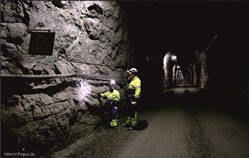 Radioactive Waste Management (RWM), the organisation designated by Government as the developer of a geological disposal facility (GDF), is planning to bring together existing geological information, at a national scale, relevant to the safety of a geological disposal facility. We want to provide authoritative information that can be used in early discussions with communities. Individual members of the Geological Society can engage in this exercise by contributing to the consultation and sharing their insights and views.
Radioactive Waste Management (RWM), the organisation designated by Government as the developer of a geological disposal facility (GDF), is planning to bring together existing geological information, at a national scale, relevant to the safety of a geological disposal facility. We want to provide authoritative information that can be used in early discussions with communities. Individual members of the Geological Society can engage in this exercise by contributing to the consultation and sharing their insights and views.
Picture: Roadway in Onkalo (Underground Rock Characterisation Facility), Finland – a repository in a ‘hard rock’ setting.
Nuclear nation
Britain has been a nuclear nation for 70 years. The world’s first commercial nuclear power station was opened by the Queen in 1956 at Calder Hall in Cumbria. However, in the early days, little thought was given to the long-term management of the resulting radioactive waste.
It has become increasingly clear that such a position is neither environmentally nor ethically sound. As the generation that has benefited from nuclear power, it is our responsibility to find a permanent solution to the challenge of radioactive waste.
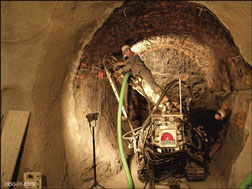 Picture: Mont Terri facility in Switzerland – a repository in lower strength sedimentary rock.
Picture: Mont Terri facility in Switzerland – a repository in lower strength sedimentary rock.
An extensive independent investigation over a decade ago concluded that geological disposal was the best available solution. Geological disposal is also the preferred option in other countries across the globe, including Sweden, France, China, USA, Canada and Germany and a number of countries are well advanced in implementation.
The principle of a GDF is to isolate radioactive waste from the surface environment and contain it for long enough to prevent harmful quantities of radioactivity ever reaching the surface. While for most types of waste, this means a few decades, some waste components remain highly radioactive for hundreds of thousands of years.
Interim waste stores at today’s power stations are actively managed, continuously monitored and maintained; but a solution that will be relied upon for many millennia requires a ‘passive’ management system. The physical environment has to play a major part in the containment process.
Safety is the first priority in radioactive waste management and RWM will not proceed with construction until it can demonstrate the safety of the facility to our regulators. Geology is one of the key elements of the environmental safety case for a GDF.
Consultation
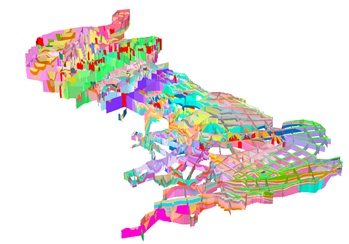 Picture: Images of the sub-surface. The GB3D geological model uses digital cross-sections of the geology across Great Britain and joins them up in a 'fence diagram'. Source: BGS.
Picture: Images of the sub-surface. The GB3D geological model uses digital cross-sections of the geology across Great Britain and joins them up in a 'fence diagram'. Source: BGS.
A Government consultation in 2013 showed that people want to know more about the sub-surface environment in order to inform early discussions about the potential to host a GDF. That is why one of the first activities outlined in the 2014 White Paper1, Implementing Geological Disposal1, is an exercise to gather together relevant existing geological information for England, Wales and Northern Ireland (Scotland has a different radioactive waste policy).
A National Geological Screening (NGS) exercise will therefore take place in 2016 to gather existing geological information relevant to the environmental safety case. It will also identify what is not known at this stage. Uncertainties about sub-surface geology increase with depth. So this exercise is not just about what we know and don’t know, but also about understanding uncertainties.
A GDF will be constructed between 200m and 1000m depth. The expanse and type of suitable rock available will be crucial in terms of the confirmed underground space required and its integrity and ability to safely store waste materials.
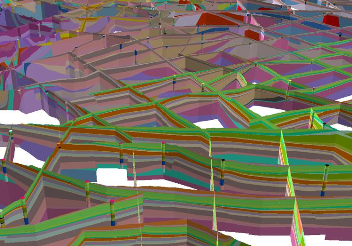
Picture: A computer image from GB3D, showing boreholes. Source: BGS.
Not all of our geological knowledge is relevant to the safety of a GDF, particularly at this preparation stage. When the siting process begins in 2017, and communities come forward wanting to learn more, then more detailed local information will be collected.
An approach has been developed by RWM with support from the British Geological Survey (BGS) and specialist geoscience professionals. This seeks to identify those geological attributes (i.e. characteristics of the geological environment) relevant to long-term safety requirements, and also to catalogue existing sources of information. Advice has also been received from RWM’s Technical Advisory Panel and its Nuclear Safety and Environment Committee. In addition, comments were provided by Regulators and the Committee on Radioactive Waste Management.
Screening
As required by the 2014 White Paper, geological screening is based on characteristics of the geological environment relevant to the long-term safety of a GDF and the requirements of the existing GDF safety cases. The five attributes ares: rock type, rock structure, groundwater, natural processes, and resources.
- Rock type attributes concern the nature and properties of the rocks present in the subsurface, including the characteristics of potential host rocks in the appropriate depth range and those of surrounding rocks that could contribute to safety. Suitable host rocks will potentially have low groundwater flow and are considered in three broad types (higher strength, lower strength sedimentary and evaporite rocks). They must be located at sufficient depth to ensure that the waste is isolated from the surface environment and have sufficient extent to accommodate the GDF. Surrounding or overlying rocks may also contribute to safety.
- Rock structure attributes concern the three-dimensional form and arrangement of different rock types and particularly the presence of geological features at depth, such as folding, faults and highly-fractured zones, which will influence the uniformity and predictability of rock properties and groundwater flow. An understanding of these attributes is important in characterising a site and demonstrating an understanding of its expected evolution. Faults often indicate locations where there is a change in the deep groundwater regime.
- Groundwater attributes concern the movement and chemical composition of groundwater present in pores and fractures in rocks from surface to a depth of around 1000m. Groundwater saturates the pores and fractures in most UK rocks below a few tens of metres depth and, where these pores and fractures are interconnected, water can move through the formations. Radionuclides and other toxic materials can be transported in groundwater from GDF depths to the surface environment. This transport is influenced by the volume of water present in the host rocks, its rates of movement and pathways to the surface environment. Slow groundwater movement and long return times are favourable for safety.
- Natural processes attributes provide information on processes such as sea-level change, erosion, earthquakes, regional uplift and the growth and retreat of ice sheets and glaciers, which are relevant to maintaining the safety of a GDF over very long timescales. Such processes are influenced by tectonic stress and by long-term climatic drivers. Favourable conditions are those where the anticipated natural processes are sufficiently slow and are adequately understood so that their consequences can be shown not to compromise the safety of the multi-barrier system.
- Resources attributes include the locations of hydrocarbon and mineral resources that are known or suspected at depth. They are relevant to GDF safety because a future society, unaware of the presence and purpose of a GDF and seeking new resources, may unwittingly drill or mine the area in which it is situated, potentially affecting the geological environment and the function of the multi-barrier system. In addition to minerals and conventional hydrocarbon resources, information will also be gathered on coalbed methane, shale gas and geothermal resources.
International panel
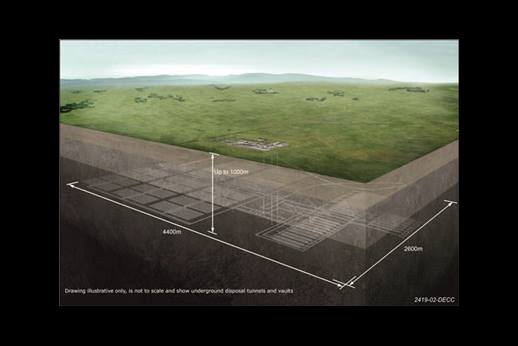 At the request of the Department of Energy and Climate Change (DECC), the Geological Society brought together an international panel of geological experts to review the technical robustness of the draft guidance. At an event on 23 June, we responded to their questions and have incorporated their comments within an updated version of the guidance.
At the request of the Department of Energy and Climate Change (DECC), the Geological Society brought together an international panel of geological experts to review the technical robustness of the draft guidance. At an event on 23 June, we responded to their questions and have incorporated their comments within an updated version of the guidance.
Picture: Artist’s impression of a GDF for the UK, in higher strength rock.
The resulting draft guidance forms the basis for a public consultation running over the autumn. This is an opportunity to invite comments and views from a much wider community. At the end of this period RWM will carefully assess all the contributions and then produce a final version of the guidance.
The guidance will be used to produce information materials for communities who may wish to talk to RWM about their potential to host a GDF. The outputs of screening will be a series of brief narratives describing the key characteristics of the geological environment and their relevance to safety. The narratives will be produced for 13 regions of England, Wales and Northern Ireland (aligned to the regional guides adopted by BGS). The narratives will be illustrated with maps, where appropriate.
As geology is a fundamental element in the long-term safety of a GDF, we hope as many members of the Society as possible will read about what we are doing and respond to the consultation.
- The public consultation on the National Geological Screening (NGS) exercise opened on 8 September 2015 and will close on 4 December. It can be found on the RWM website at: http://bit.ly/1US7Fde
* Natalyn Ala is GDF Siting Director for Radioactive Waste Management (RWM). She is a Fellow of the Geological Society, Council member and Secretary of the Society’s Professional Committee.
Reference
- https://www.gov.uk/government/publications/implementing-geological-disposal